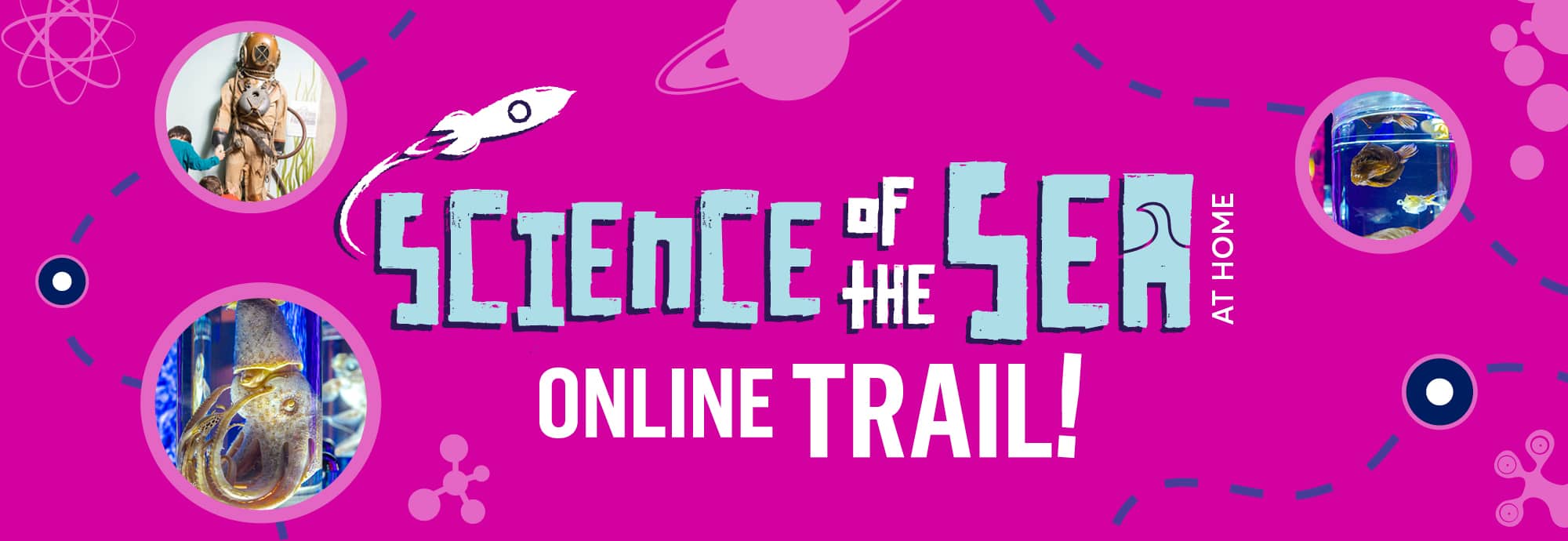Welcome to the Aliens of the Deep Family Trail. Are you ready for an adventure? This online trail takes you on a journey in search of alien life.
You will explore the Monsters of the Deep exhibition where you will take the plunge into the deep sea. With near freezing temperatures, no sunlight and crushing pressure, the darkest depths of the ocean seem like an unlikely place to find life. But here you will find a world filled with alien creatures including vampire squid, anglerfish and giant isopods. Now scientists are studying the ocean to understand the possibilities of exploring outer space in the search for extra-terrestrial life.
Testing, testing 1, 2, 3
As you move through our online trail click on the images to see more information, hear about the Monsters of the Deep exhibition from our museum experts and learn about the possibilities of alien life in outer space from our resident Explorer Dome scientists. Give it a go below!
Welcome to the first stop on the trail – the Carta Marina Map
What do you think an alien might look like? Are they real or fictional?
This map is a giant reproduction of the Carta Marina, the world’s most famous medieval map. This map is very important because it shows the creatures that medieval people imagined lived under the sea. Look closely, how many monsters of the deep can you spot?
We now know a lot more about the creatures that really live in the sea, however scientists have not explored a large amount of the ocean. This is a lot like space, we’ve started to explore but there is so much left to discover. If you were to draw a map of space what would it look like? What things do you already know and what do you have to imagine?
Click on the symbols below to learn more!
Here we are at stop two – say hello to Sarah, the Museum’s Curator.
Is that an alien?! What do you think? Click on the image to hear NMMC’s Curator, Sarah Riddle tell you more.
Stop three – are there monsters in the stars?
From the seas to the stars -look at this celestial table globe, circa 1613, it’s a map of the stars. But what are those creatures? Why are they there?
Stop four – hear more from our scientist Ben
Conditions in the deep sea and outer space are extreme, scientists rely on technology to explore these environments. Click on the image below to hear from Ben our Explorer Dome scientist as he delves into the frozen moons Europa and Enceladus, where life similar to that found on earth may be lurking.
You’re doing great! Let’s take a quick break and visit the Tidal Zone.
Welcome back to the trail – you’ve now reached stop five
During the 1870’s the British ship HMS Challenger explored the Atlantic and Pacific oceans. The Challenger Expedition was the first major, dedicated scientific investigation of the shape, size, depth, and life of the world’s oceans. On board the HMS Challenger scientists discovered around 4700 species of marine life including fish, coral, molluscs and crustaceans. They also identified one of the deepest parts of the ocean, the Challenger Deep, in the Pacific Ocean. The discoveries were so important to the development of science that the space shuttle Challenger was named after the expedition.
Click the play button to hear exhibition expert Stuart tell you more.
Here’s stop six – discover strange alien lifeforms, from the sea!
Take a deep breath and plunge down deep into the ocean. What do you imagine you would experience? At first there would be some light, but this would quickly fade. Keep diving and the temperature will drop to almost freezing, pressure will rise and sunlight will disappear. It’s hard to imagine anything living here, yet, there is life- the deep ocean is filled with strange life forms including fish, sea stars, jellyfish and worms.
Look at the specimens on display to discover more about the strange creatures living in the depths of the ocean. As you reach the bottom of the ocean, hear from Explorer Dome scientist Ben as he reaches the most distant parts of space.
–
Hear from Museum Curator Sarah as she takes a closer look at the weird and wonderful creatures on display.
–
Take a closer look. What do you see? How many legs do they have? Do they have big or small eyes? What colour are they? How big are their teeth?
–
–
–
–
Well done – you have travelled from the depths of the ocean to distant worlds in space. What a journey!
Take one last look around Monsters of the Deep – from the air!
Thanks to Bad Wolf Horizon for the incredible footage of the Monsters of the Deep exhibition.
Find all the videos from the trail (and more!) on National Maritime Museum Cornwall’s YouTube channel.



